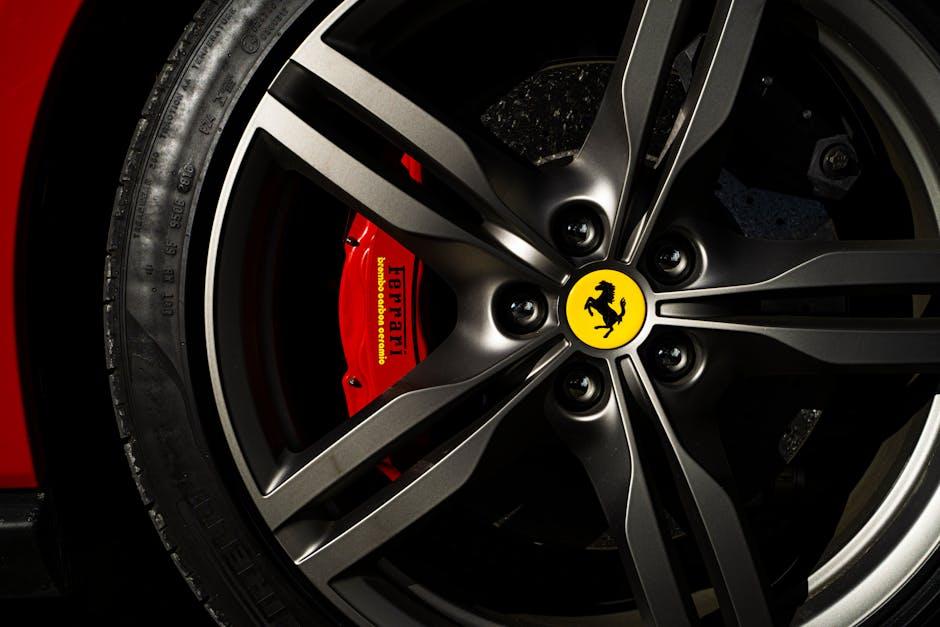Selecting the perfect set of tires for your vehicle is more than just a routine purchase—it’s an essential decision that affects safety, performance, and comfort on every journey. With countless options available, each promising durability, grip, and efficiency, the process can quickly become overwhelming. Whether you’re navigating city streets, cruising highways, or tackling rugged terrain, understanding how to choose the best tires tailored to your driving needs can transform your ride and peace of mind. In this guide, we’ll explore the key factors to consider, helping you steer confidently toward the ideal tires for your vehicle.
Table of Contents
- Understanding Your Vehicle’s Tire Requirements
- Decoding Tire Types and Their Best Uses
- Evaluating Tire Performance: Traction, Durability, and Comfort
- The Importance of Tire Size and Load Ratings
- Seasonal Considerations for Optimal Tire Selection
- Tips for Budgeting Without Compromising Quality
- Q&A
- Closing Remarks

Understanding Your Vehicle’s Tire Requirements
Every vehicle has specific tire requirements that play a crucial role in safety, performance, and efficiency. These requirements stem from the manufacturer’s recommendations, which take into account the vehicle’s weight, engine power, and intended use. Tire size, load index, and speed rating are not just numbers; they are carefully calibrated specs to ensure the tire can handle the vehicle’s demands under varying conditions. Ignoring these details can lead to compromised handling, uneven wear, or even dangerous blowouts.
To make an informed choice, familiarize yourself with factors such as:
- Load Capacity: Ensures the tire supports the vehicle’s weight.
- Speed Rating: Indicates the maximum speed the tire safely handles.
- Tread Pattern: Matches your driving conditions – from highways to off-road.
- Tire Size: Found on the sidewall or owner’s manual, critical for fit and performance.
| Specification | Common Example | What It Means |
|---|---|---|
| Tire Size | 215/55R17 | Width, aspect ratio, and rim diameter |
| Load Index | 94 | Maximum load capacity per tire (670 kg) |
| Speed Rating | V | Safe up to 149 mph (240 km/h) |

Decoding Tire Types and Their Best Uses
Choosing the right tire starts with understanding the variety available and the specific benefits each type offers. All-season tires deliver balanced performance ideal for moderate climates, providing a reliable grip on both wet and dry roads. In contrast, summer tires excel in warm weather, featuring tread designs that enhance cornering and braking on dry pavement but may struggle in cold or snowy conditions. For the adventurous or those living in regions with harsh winters, winter tires are engineered with specialized rubber compounds and deeper tread patterns to maintain traction on icy and snowy surfaces.
Picking the suitable tire is not just about weather compatibility but also how you use your vehicle daily. Consider these key attributes:
- All-season: Versatility and longer tread life
- Summer: Superior grip and handling performance
- Winter: Enhanced safety in snow and ice
- Performance tires: Designed for sporty driving with improved responsiveness
- Off-road tires: Built for rugged terrains with reinforced sidewalls
| Tire Type | Best Use | Season | Durability |
|---|---|---|---|
| All-season | Daily commuting, light road conditions | Year-round | High |
| Summer | Performance driving on dry roads | Warm months | Moderate |
| Winter | Snowy and icy conditions | Cold months | Moderate |
| All-terrain | Mixed off-road and highway use | Year-round | High |

Evaluating Tire Performance: Traction, Durability, and Comfort
When selecting tires, understanding how well they perform in traction is crucial. Traction not only affects your vehicle’s grip on various road conditions but also your overall safety. Tires with deep, well-designed treads excel in wet or slippery environments, reducing the risk of hydroplaning. On the other hand, specialized tires like all-terrain or winter variants offer enhanced traction by incorporating unique rubber compounds and tread patterns tailored for off-road or icy surfaces. Prioritizing the right traction capabilities ensures confident handling whether you’re navigating urban streets or venturing off the beaten path.
Durability and comfort often go hand-in-hand in evaluating tire quality. A robust tire delivers long-lasting tread life and withstands harsh driving conditions such as rough roads or extreme temperatures. However, a tire that’s too rigid may compromise ride comfort, leading to vibrations and noise inside the cabin. Look for tires featuring innovative sidewall technologies or noise-reducing tread designs to strike a balance. Here’s a quick comparison to help guide your choice:
| Feature | Impact on Durability | Impact on Comfort |
|---|---|---|
| Rubber Compound | Resistant to wear and tear | Flexible for smooth rides |
| Sidewall Design | Enhanced protection from impacts | Absorbs shocks and reduces vibrations |
| Tread Pattern | Improves lifespan in various terrains | Minimizes road noise |

The Importance of Tire Size and Load Ratings
Choosing the right tire size and load rating is essential for ensuring your vehicle performs safely and efficiently. Tires that are too small or too large can lead to inaccurate speedometer readings, reduced fuel efficiency, and even compromised handling. Load ratings, on the other hand, indicate the maximum weight a tire can safely carry. Ignoring these specifications risks tire failure, which can jeopardize your safety and that of others on the road. Always refer to your vehicle’s manufacturer recommendations and confirm the tire size matches the rim and suspension design for optimal driving experience.
Key factors to consider include:
- Matching tire size to manufacturer’s specs to maintain stability and balance
- Ensuring the load rating exceeds the maximum vehicle load for durability and safety
- Considering different load ratings for front and rear tires if applicable
| Tire Size | Load Rating | Recommended Use |
|---|---|---|
| 205/55R16 | 91 (1356 lbs) | Compact cars, everyday commuting |
| 225/60R17 | 99 (1709 lbs) | Midsize SUVs, light trucks |
| 275/40R20 | 106 (2065 lbs) | Performance cars, heavy-duty use |

Seasonal Considerations for Optimal Tire Selection
When choosing tires, understanding the climate and weather patterns of your driving area is crucial. Winter tires are engineered with special rubber compounds and tread designs that remain flexible and provide excellent traction on snow and ice. Conversely, summer tires offer superior grip on dry and wet roads but can harden in cold temperatures, reducing performance. If you experience a mix of conditions, all-season tires provide a compromise, balancing moderate performance across different weather but may fall short in extreme winter or summer scenarios. Taking into account the typical temperature range and precipitation in your region will ensure safer travels and enhanced tire longevity.
Seasonal changes also influence the rate of tire wear and the necessary maintenance routines. For instance, the aggressive tread of winter tires can wear faster on hot asphalt, while summer tires are prone to cracking when used in freezing conditions. Consider the following factors to match your tires to seasonal needs:
- Temperature Variability: Opt for tires designed for the specific temperature range.
- Road Conditions: Snow, ice, rain, or dry asphalt require different tread patterns for optimized grip.
- Usage Frequency: Seasonal tires might need replacement or swapping if conditions change frequently.
| Season | Recommended Tire Type | Key Benefits |
|---|---|---|
| Winter | Winter Tires | Enhanced traction on snow/ice, flexible rubber |
| Summer | Summer Tires | Optimal grip on hot, dry roads |
| Year-Round | All-Season Tires | Balanced performance in varied conditions |

Tips for Budgeting Without Compromising Quality
Stretching your tire budget doesn’t mean settling for less. Start by focusing on value over price — a slightly higher upfront cost can save you money in the long run with enhanced durability and performance. Look for brands that balance quality materials and innovative tread designs without overwhelming marketing premiums. Additionally, shop during off-season sales or clearance events, which can yield significant discounts on premium models. Remember, maintaining proper tire pressure and rotating tires regularly also prolong their life, so allocate some budget for routine care.
Consider using the following checklist to get the most bang for your buck:
- Compare warranties: Longer and comprehensive coverage often reflects confidence in the tire’s durability.
- Check fuel efficiency ratings: Some tires offer lower rolling resistance, saving on gas expenses.
- Evaluate tire lifespan: Tires with better treadwear ratings typically need less frequent replacement.
- Read consumer reviews: Real-world feedback can reveal hidden pros and cons that specs might not show.
| Factor | Budget-Friendly Option | Premium Upgrade |
|---|---|---|
| Warranty | 40,000 miles | 70,000 miles |
| Tread Life | 40,000 miles | 60,000 miles |
| Rolling Resistance | Standard | Low |
| Price (per tire) | $70 – $90 | $110 – $160 |
Q&A
Q&A: How to Choose the Best Tires for Your Vehicle
Q1: Why is choosing the right tires important for my vehicle?
A1: Tires are the only contact point between your vehicle and the road. The right tires ensure safety, improve handling, enhance fuel efficiency, and provide a comfortable ride. Choosing poorly can lead to decreased performance and increased risk of accidents.
Q2: What factors should I consider when selecting tires?
A2: Key factors include your vehicle type, driving conditions, climate, tire size, tread pattern, and budget. It’s essential to match tires to how and where you drive to get the best performance and durability.
Q3: How do I know what tire size fits my vehicle?
A3: Check your vehicle’s owner manual or the tire placard located on the driver’s door jamb. Tire size is typically written in a format like “225/50R17,” which includes width, aspect ratio, and rim diameter. Using the correct size ensures proper fit and function.
Q4: What’s the difference between all-season, summer, and winter tires?
A4: All-season tires offer balanced performance in a variety of conditions, ideal for moderate climates. Summer tires excel in warm, dry, and wet conditions but aren’t suitable for cold or snowy roads. Winter tires are designed for excellent grip on snow and ice but wear faster in warm weather.
Q5: How does tread pattern affect tire performance?
A5: Tread patterns influence traction, noise, and water evacuation. Symmetrical treads provide smooth, quiet rides; directional treads excel at channeling water to reduce hydroplaning; and asymmetric treads balance dry and wet performance for a versatile experience.
Q6: Should I consider tire brands or just price?
A6: Brand reputation often reflects quality and reliability, but it’s not the only factor. Look for tires with good reviews, solid warranties, and safety ratings. Sometimes mid-range tires offer better value than premium ones for your specific needs.
Q7: When is the best time to replace my tires?
A7: Replace tires when tread depth falls below 2/32 inches, if you notice cracks or bulges, or if tires are over six years old, regardless of appearance. Regularly inspect your tires to ensure they remain safe and effective.
Q8: Can I mix different types or brands of tires on my vehicle?
A8: It’s generally recommended to use matching tires on all four wheels for balanced performance and safety. Mixing brands or types can lead to uneven traction, handling issues, and faster tire wear.
Q9: How does tire maintenance impact tire life?
A9: Proper inflation, regular rotation, alignment checks, and balancing extend tire life and maintain performance. Neglecting maintenance can cause uneven wear and premature replacement.
Q10: Where can I get professional advice on choosing tires?
A10: Tire specialists at dealerships, tire shops, or automotive service centers can assess your needs based on your vehicle, driving habits, and local conditions to recommend the best options. Online resources and reviews can also help guide your choice.
Choosing tires wisely is key to a safe and enjoyable driving experience. Keep these considerations in mind to roll smoothly down the road.
Closing Remarks
Choosing the perfect tires for your vehicle is more than just a routine purchase—it’s about enhancing safety, performance, and your driving experience. By understanding your vehicle’s needs, road conditions, and your own driving habits, you can make an informed choice that keeps you rolling smoothly mile after mile. Remember, the right tires aren’t just a set of rubber circles; they’re the foundation of every journey you take. So take the time, do the research, and let your tires be the silent partners that carry you confidently wherever the road leads.

